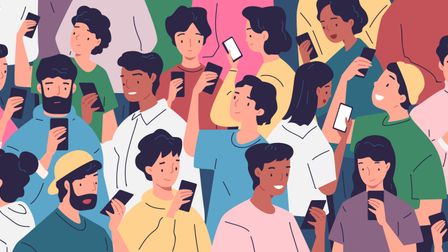Beyond the screen: How the next five years will redefine how we watch
Audiences are used to a defined frame and a curated viewing experience. But, asks Patrick Gather, Chief Innovation Officer and Creative Director at Wonderhatch, as our viewing habits broaden and technology evolves, how might the way we watch change in the coming years?
During a recent episode of Theo Von’s This Past Weekend podcast, Meta co-founder Mark Zuckerberg made a comment that sparked a thought.
“All this digital stuff should just basically be holograms. You shouldn’t need a physical screen.”
“All this digital stuff should just basically be holograms. You shouldn’t need a physical screen.”
At first it sounded like just another far away, Silicon Valley vision. But if you look at what’s happening in parallel, the rise of wearable technology like Meta’s Orion glasses, immersive installations like the Las Vegas Sphere, and evolving tools like Apple Vision Pro, it’s clear this isn't perhaps that distant a fantasy.

Above: Apple's Vision Pro is evidence that immersive tech - and audiences' move towards it - is happening, says Gather.
Over the past five years, these innovations haven’t just changed what we see, they’ve reshaped how we see it. As both Head of Innovation and Creative Director, I’m fascinated by this intersection. The more our tools evolve, the more pressing the question becomes: What does the future of watching actually look like?
From spectator to participant
Traditionally, we’ve viewed content as observers; seated, still and within the comforting frame of a screen. But what happens when we blur the boundary between audience and experience?
This shift from passive watching to active participation isn’t just a trend, it’s a pretty fundamental reimagining of what it means to be immersed. In the future, technology will hopefully serve less as a spectacle or gimmick and more as a silent conduit to emotional depth. Whether it’s an ad, a short film or a live-streamed concert, the best tech should disappear, leaving us with only the story to enjoy.
What happens when we blur the boundary between audience and experience?
Still, it’s essential to acknowledge the spectrum of adoption. While early adopters like myself can get excited by the potential of VR-enhanced storytelling or AI-personalised content, many viewers simply want to unwind. For them, a comfortable couch and a 16:9 screen remains the gold standard.
And that's okay. Future success will depend on coexistence. We need to be keeping traditional formats alive while expanding into new canvases for those who seek them.

Above: Traditionally we've viewed content as inactive observers, "seated, still and within the comforting frame of a screen", but things are changing.
Is an expanded canvas always better?
The director’s role is rooted in guiding attention through lenses, framing, lighting, editing. But what happens to that visual guidance when there’s no longer a defined frame? This is one of the most interesting creative challenges facing immersive content today.
In 360 degree worlds or VR experiences, the viewer decides where to look. Directors are beginning to explore tools like spatial audio cues, reactive environments, and emotional AI to steer attention.
What happens to [a director's] visual guidance when there’s no longer a defined frame?
But even as our visual field expands, we need to ask: is more always more? A carefully composed frame has been able to transport us into a story for over a hundred years just as powerfully as a virtual world. It’s not a binary choice between passive and interactive. Escapism can exist in both. And sometimes, after a long day, the last thing you want is to ‘interact’.
The key is comfort and ease. If immersive experiences are clunky, expensive or exhausting, they will remain a novelty. If they’re seamless, light and intuitive? That’s where the shift happens.

Above: We're used to viewing through a defined, curated frame... but what happens when that frame expands?
Branded worlds, ethical warnings, and creative rebirth
In advertising, the implications are just as radical and potentially even more exciting.
We have already started seeing initial attempts for frameless, branded worlds that don’t just sell a product, but tell a story across several touchpoints - interactive films, immersive games, and real-world AR. Collaborations between brands and entertainment IP could unlock whole ecosystems of storytelling, where each informs and influences the other.
As immersive and personalised experiences grow, so must our commitment to data privacy, transparency, and emotional wellbeing.
But this expanded canvas also raises ethical questions. If content is AI-personalised, what data is being used? And how much customisation is too much? As immersive and personalised experiences grow, so must our commitment to data privacy, transparency, and emotional wellbeing. The same algorithms that deepen emotional engagement can easily tip into manipulation.
It’s all about balance - crafting experiences that are both personalised and respectful. It’s not enough to just reach the audience, but we need the content to resonate and stick.

Above: Projects such as ABBA Voyage are proof that technologically enhanced experiences can be something which audiences gravitate towards.
The future isn't just tech
Technologically, we are not there yet. Hardware is heavy, battery life is short and most people don’t want to wear goggles every time they want to experience films or ads. But the trajectory is promising. With the success of projects like ABBA Voyage, VR installations like Otherworld and entertainment landmarks like The Sphere, audiences are clearly curious.
And let’s not forget - old media isn’t dying. Print, TV, and traditional cinema are still alive, often innovating in their own right. The future isn’t about replacement, it’s about expansion. New tools don’t render the old ones obsolete, they offer more options for connection, emotion and storytelling.
Ultimately, viewers will decide which experiences endure. Our role, as both creatives and innovators, is to ensure that each new canvas is explored in order to craft moments that feel meaningful, intuitive and human - no matter if it’s through a screen, a headset or a hologram.
)







